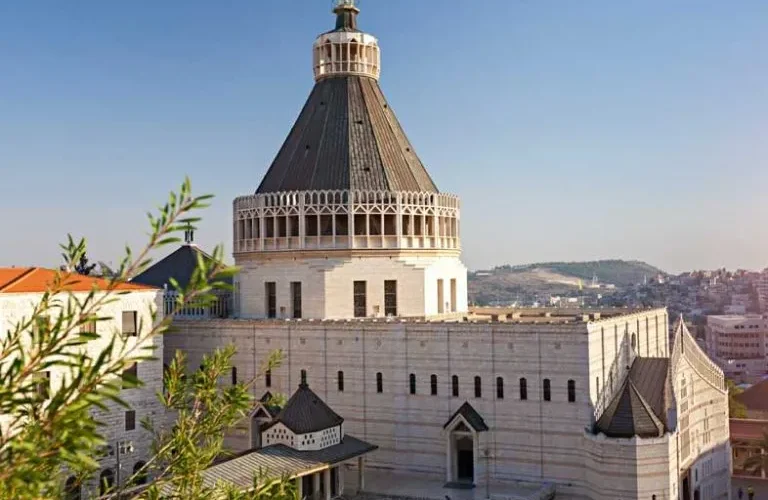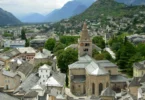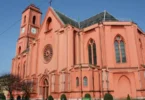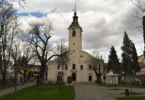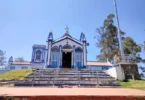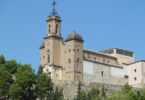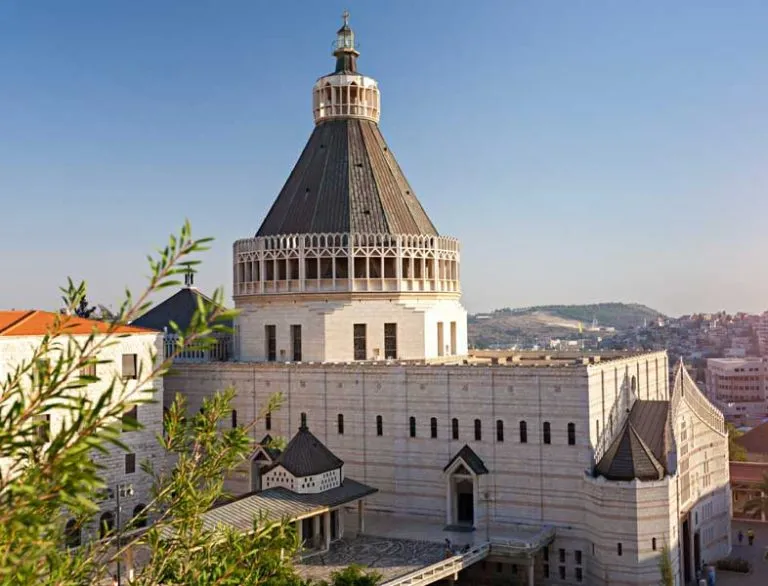
Introduction
The Church of the Annunciation sometimes also referred to as the Basilica of the Annunciation, is a Catholic church in Nazareth, in northern Israel. It was established over what Catholic tradition holds to be the site of the house of the Virgin Mary, and where the angel Gabriel appeared to her and announced that she would conceive and bear the Son of God, Jesus – an event known as the Annunciation. The church, an outstanding building in the center of town, is built where it’s believed the house the Virgin Mary was.
The Church of the Annunciation in Nazareth commemorates the place where the angel Gabriel visited Mary and delivered the invitation for her to bear God’s Son.
The Gospels of Matthew and Luke both describe the birth of Jesus, but they disagree as to where Joseph and Mary lived before Jesus’ birth. Luke has them living in Nazareth, and records show early pilgrims traveling here to venerate this area as the place of the Annunciation.
The Church is the largest in the Middle East—its giant cupola dominates the whole city. It was constructed over the course of a decade in the 1950s and 1960s and was finished after Vatican II concluded. The architectural style is called “Italian brutalist” and uses exposed, unfinished concrete to highlight naked natural elements.
An older church from 1730 was cleared for this new building, and Pope St. John XXIII decided to explore the archaeology when they opened the site. No previous historical study had been done there before, though records indicate that pilgrims visited the place as early as the fourth century.
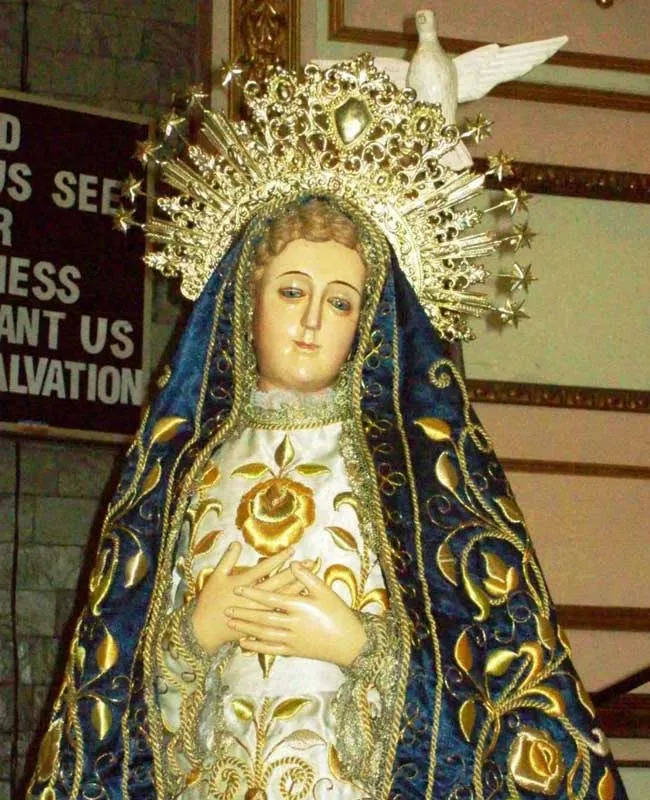
Archaeologists found a grotto there surrounded by a fourth century church. Inside the grotto they found a foundation of stone from even earlier (possibly third century) with the words of Gabriels’ greeting, “Hail Mary,” inscribed on it. Because of the significance of the historical connection to the place, they built the new church around this grotto, leaving it exposed in the bottom level.
Above the door of the church is inscribed the Latin phrase, Verbum caro factum est et habitavit in nobis, which means, “The Word was made flesh and dwelt among us.” A similar phrase is inscribed below the altar inside the grotto that was excavated in the bottom of the church—the place that is believed to be Mary’s home where the angel Gabriel visited her.
The architecture of the church emphasizes vertical spaces and calls to mind the way God descended to take on human form as Mary’s Son. And the further one descends, the closer one gets to the actual space where this event took place – visitors have the feeling that they are peeling back layers of history. The white cupola reminds visitors of the petals of a lily – a traditional symbol of purity associated with Mary.
The staff at the church also makes a point of offering generous hospitality. When a Notre Dame group of pilgrims visited the church for Mass, a Holy Cross priest noted that a Franciscan brother in the sacristy helped him fit his arms and head into his vestments. It is a fitting gesture – hospitality because it commemorates a great act of hospitality in Mary’s accommodation of Jesus in her womb.
History of the Basilica of the Annunciation, Nazareth
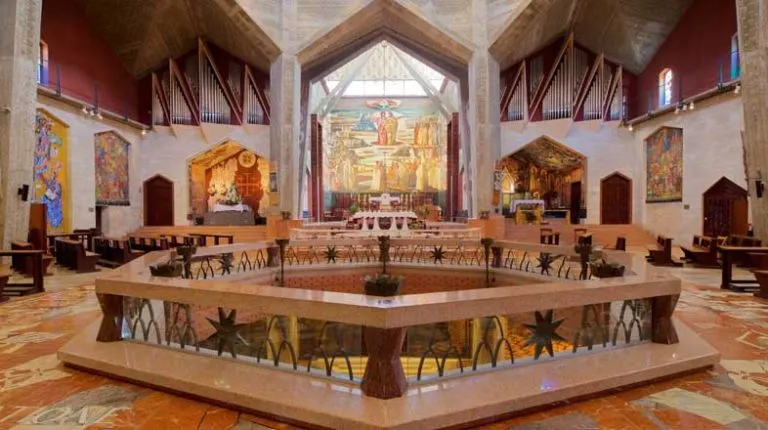
Basilica of the Annunciation, Nazareth was established at the site where, according to one tradition, the Annunciation took place. Another tradition, based on the apocryphal Proto evangelium of James, holds that this event commenced while Mary was drawing water from a local spring in Nazareth, and the Greek Orthodox Church of the Annunciation was erected at that alternate site.
Basilica of the Annunciation, Nazareth, the first church was established during the Byzantine times, probably around the year 427. It was built by Jerusalem’s Deacon (one of the 3 positions in the Christian clergy, next to the priest and the bishop), who was called Conon, which can be seen from the writing “Conon” on the mosaic floor, close to the cave.
The church was built as a large central hall, with a small monastery to the south. Some steps led to the holy cave which was almost completely separated from the church itself. In the year 670, Arculpus spoke of 2 churches in Nazareth: Church of Joseph and The Church of Annunciation. The church was in use for about 700 years, during which several repairs were made.
After Palestina-Israel was conquered by the Muslims in 638, Muslims demanded large payments from the Christians in order to permit the churches’ existence. However, the condition of the Church was worsening until it was almost completely derelict at the beginning of the Crusader’s Times around the 11th century.
When the Crusaders arrived to Nazareth, they found the church to be completely destroyed. Tancred, Prince of Galilee, rebuilt the church and established there a marvelous, impressively large Basilica. The remains of this Basilica are integrated now into the new church which was built over Tancred’s Church. During this time, the site of Annunciation was located inside the church where stairs were leading directly to it and a small altar was built above, the remains of which still exist today.
It seems like the Crusader-era Church was never complete, especially when it comes to the artistic objects – five Romanic crowns found around the church can indicate on that. The remains of the Church show that it had at least 64 crowns. Several excavations exposed the church’s foundations: the Northern wall (integrated in the current church), as well as different artistic remains.
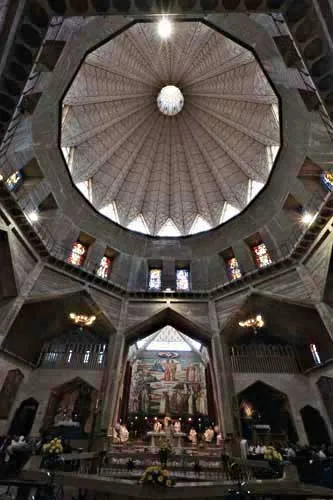
However, the Crusader-era church didn’t last for too long and was destroyed in 1263 by the Mamluk Sultan Baibers. The Christians’ source of pride became a symbol of disgrace. The place was deserted for many years in spite of the Franciscans’ efforts to settle down there, efforts that have failed. They encountered a hostile Muslim community and a government who refused to permit their presence in the area.
Eventually, around 1620, in the beginning of the Ottoman era, the Franciscans were allowed to return by the Druze Emir Fakr ad-Din. They have settled in Nazareth, close to the Church of Annunciation and were possession over the cave and the Basilicas’ remains, from which they have built a modest monastery. Ever since then, the vicinity has been under to authority of the Franciscan Order, although from time to time they have been forced to abandon the place by Muslim rulers. However, they have always returned. In 1935 Amir Fakhr al-Din was executed and the Damascus Basha avenged those who enjoyed his protection.
The Nazareth Franciscans were arrested for 6 weeks and released only after paying a large amount of money. In 1938 they had to leave again due to harassment by the Bedouins, but returned 3 years later. Pilgrims who visited Nazareth in 1644 indicated that the area of the Annunciation Cave was still destroyed.
The Franciscans managed to rebuild the Church only around 1730, after Daher al-Omar, govenor of the Galilee permitted them to do so. They were only given 6 months – the time period required for a Muslim to make a pilgrimage to Mecca and return.
As a result, the new Church was modest and meant to provide immediate needs only, not reflecting its true Christian meaning. The Church was small and consisted of a central hall and 2 secondary wings. The altar was built above the cave. Wide steps led down to the cave itself, with a hallway at the end called “The Angel’s Chapel” and 2 altars – one for Joachim and Anna and the other for Archangel Gabriel.
The room was used as a gateway for the Chapel. The Altar of Annunciation was in the center of the cave, with another Altar dedicated to St. Joseph in the back. In 1877 the church was renovated and expanded, and the façade was rebuilt. In 1955 the current Basilica of the Annunciation was built and the old one was destroyed. The monastery and Franciscan School were built next to it in 1930.
Architecture of the Basilica of the Annunciation, Nazareth

Architectural Style: Modern Architecture
The Catholic Church of Annunciation, the biggest, most magnificent church in the Middle East. It was designed by Italian architect Giovanni Muzio, built by Solel Boneh and established in 1969. The church has two stories which provide enough space for a large amount of worshipers as well as preservation of the holy cave and remains of the previous churches. The church is a powerful, monumental building inducing a sense of eternity.
The cave is located in the center of the lower floor. This area is slightly dark maintaining the mysterious atmosphere surrounding the wonder of the Annunciation. This level is also where the remains of previous churches are preserved. The stone wall along the church and behind the cave has remained from the Crusader-era church from the 12th century. Excavations have revealed some Crusader-era atrifacts – some of the most beautiful pieces of art from those times, which are presented in the museum located under the plaza outside of the higher level.
The lower level presents the architectural fortitude required for building this Church. Above, the marvelous lily dome is a symbol to Virgin Mary’s purity. On the marble floor you can find the names of the popes, and the large mosaic painting of the Italian painter Salvador Puma, describing Jesus, Virgin Mary and St. Peter, is located on front.
On the church walls, as well as in its yard, is presented an exhibition of mosaic paintings. Each painting was given by a different country and is reflecting the national motives of the country it was made at.
On the lower level is the most holy place – Mary’s cave, the cave in which, according to the Catholic-Christian tradition, Mary was visited by Archangel Gabriel and told her she is destined to carry Jesus in her womb. The first church was built on the site in 427 A.D, and a few others have been built and destroyed since. In the current building which was established in 1969, there are still remains of the previous churches. It is one of the biggest, most impressive churches in the Middle East.
The breath-taking Basilica is 59.5 meters high and houses colorful mosaics depicting the Holy Family. The mosaics were made by Christian communities from all over the world, and every piece of art reflects the national character of the country that sent it.
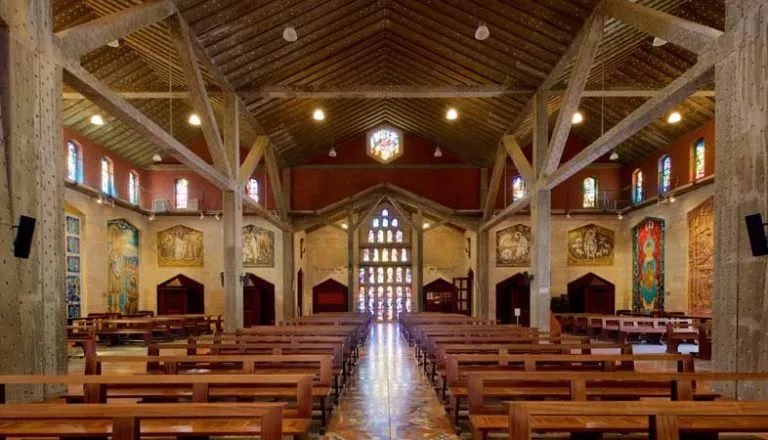
Late Roman / Byzantine Shrine
Christian tradition has held that a structure was commissioned by Emperor Constantine I, whose mother, Saint Helena, helped to found churches commemorating important events in Jesus Christ’s life. The Church of the Annunciation was founded around the same time as the Church of the Nativity (the birthplace) and the Church of the Holy Sepulchre (the tomb). Some version of it was known to have still been in existence around 570 AD.
A competing view is that the Church was the site of the Holy House of Loreto, which, according to Christian legend, was transported by angels across the sea to Loreto, Italy, at the time of the Muslim conquest.
Crusader Church
The second church was built over the ruins of the Byzantine era church during the Crusades, following the conquest of Nazareth by Tancred in 1102. The Crusader era church was never fully completed. Five Romanesque capitals carved by artists from northern France, and discovered during excavations in 1909, had not yet been installed in 1187 when news of Saladin’s victory in the Battle of Hitting reached the city.
Saladin granted permission to Franciscan priests to remain in Nazareth to oversee services at the church. In 1260, Baybars and his Mamluk army destroyed the church during their attack on Nazareth.
Mamluk and early Ottoman period
A small number of Franciscans managed to stay in Nazareth until the fall of Acre in 1291. In the three centuries that followed, the Franciscans were in and out of Nazareth, depending on the local political situation, which was constantly in flux. Franciscan accounts of this period document their expulsion in 1363, their return in 1468 and a massacre of some of their members in 1542. Local Christian families with Franciscan support took care of the holy site even during this difficult period.
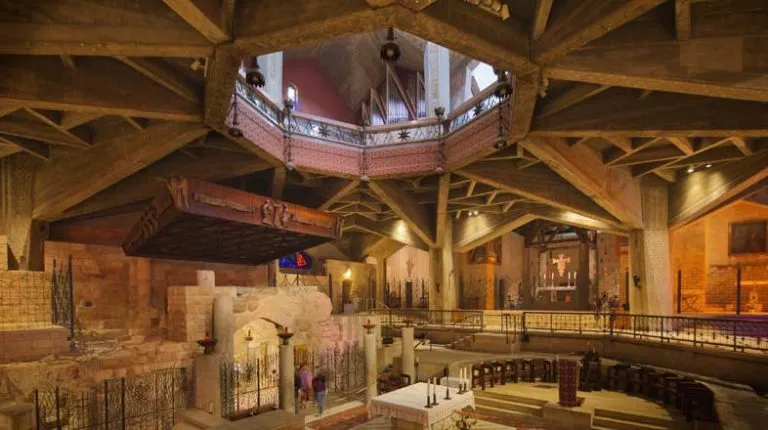
17th & 18th Century Churches
Emir Fakhr ad-Din granted the Franciscans permission to return to Nazareth and the church ruins in 1620, at which time they constructed a small structure to enclose the holy grotto that is venerated as the house of Mary.
In 1730, Dahir al-Umar permitted construction of a new church, which became a central gathering place for Nazareth Latin community. The church was enlarged in 1877.
20th Century Basilica
The old church was completely demolished in 1954 to allow for the construction of a new basilica. The new basilica was designed by the Italian architect Giovanni Muzio, and built by the Israeli building firm Solel Boneh during the years 1960–1969. The Chief Engineer at this project was Ing. Shlomo Lopatin (Aluf) who was dedicated to the Basilica building process for more than 10 years, and it was indeed his life-project. It is built in a style sometimes characterised as Italian Brutalism.
Pope Paul VI celebrated Mass in the new church during his trip to the Holy Land in 1964. The basilica was completed in 1969.
Used by the Latin parish, it remains under the control of the Franciscans. It is the largest Christian Church building or sanctuary in the Middle East under the supervision of the Congregation for the Oriental Churches.
Pope John Paul II made a pilgrimage to the Holy Land for the Great Jubilee of 2000 and celebrated Mass at the Basilica of the Annunciation on March 25, 2000.
Under Canon Law, the church enjoys the status of a minor basilica. A historically significant site, considered sacred within some circles of Christianity, particularly Catholicism, the basilica attracts many Catholic, Anglican, and Eastern Orthodox Christian visitors every year.
The current Catholic Church is a two-story building finished in 1969 over the site of earlier churches from the Byzantine, Crusader, and the Israeli – period churches.
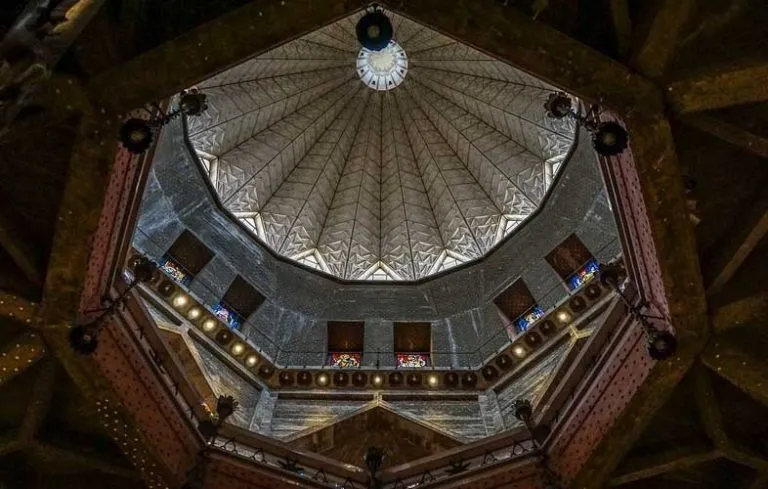
Lower Church
The lower level contains the Grotto of the Annunciation, believed by many Christians to be the remains of the original childhood home of Mary.
Upper Church
The upper level contains a number of images of Mary, mainly mosaics, each from a different country with significant Catholic population.
Courtyard gallery of Madonnas
On the walls enclosing the courtyard of the basilica, there is a gallery with icons (mainly mosaics, but also some made of ceramic tiles) representing some of the most important Marian devotions in different countries. Some of the main Marian devotions from Spain are included: the Virgin of Candelaria, patron saint of the Canary Islands; the Virgin of Montserrat, patroness of Catalonia; the Virgin of the Forsaken, patroness of Valencia; and the Virgin of Guadalupe, patroness of Extremadura.
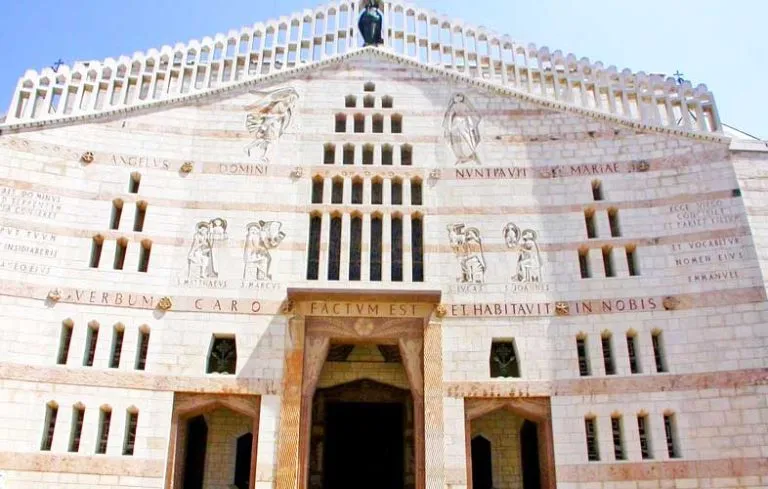
First - Century House
In December 2009 the Israel Antiquities Authority announced the discovery of a house from the time of Christ, on a property next to the Church of the Annunciation. The authority described it as “the very first” residential building found from the old Jewish village.
Small and modest, the house consisted of two rooms and a courtyard with a cistern to collect rainwater. The remains of the house were found during an excavation prior to construction of the Mary of Nazareth International Center. They are conserved and displayed inside that building.
Feast Day – 25th March
The Feast of the Annunciation, contemporarily the Solemnity of the Annunciation, and also called Lady Day, the Feast of the Incarnation or Conceptio Christi (Christ’s Conception), commemorates the visit of the archangel Gabriel to the Virgin Mary, during which he informed her that she would be the mother of Jesus Christ, the Son of God. It is celebrated on 25 March each year. In the Roman Catholic Church, when 25 March falls during the Paschal Triduum, it is transferred forward to the first suitable day during Eastertide.
In Eastern Orthodoxy and Eastern Catholicism, it is never transferred, even if it falls on Pascha (Easter). The concurrence of these two feasts is called Kyriopascha. The Feast of the Annunciation is observed almost universally throughout Christianity, especially within Orthodoxy, Anglicanism, Catholicism, and Lutheranism. It is a major Marian feast, classified as a solemnity in the Catholic Church, a Festival in the Lutheran Churches, and a Principal Feast in the Anglican Communion.
In Orthodox Christianity, because it announces the incarnation of Christ, it is counted as one of the eight great feasts of the Lord, and not among the four great Marian feasts, although some prominent aspects of its liturgical observance are Marian. Two examples in liturgical Christianity of the importance attached to the Annunciation are the Angelus prayer, and especially in Roman Catholicism, the event’s position as the first Joyful Mystery of the Dominican Rosary.
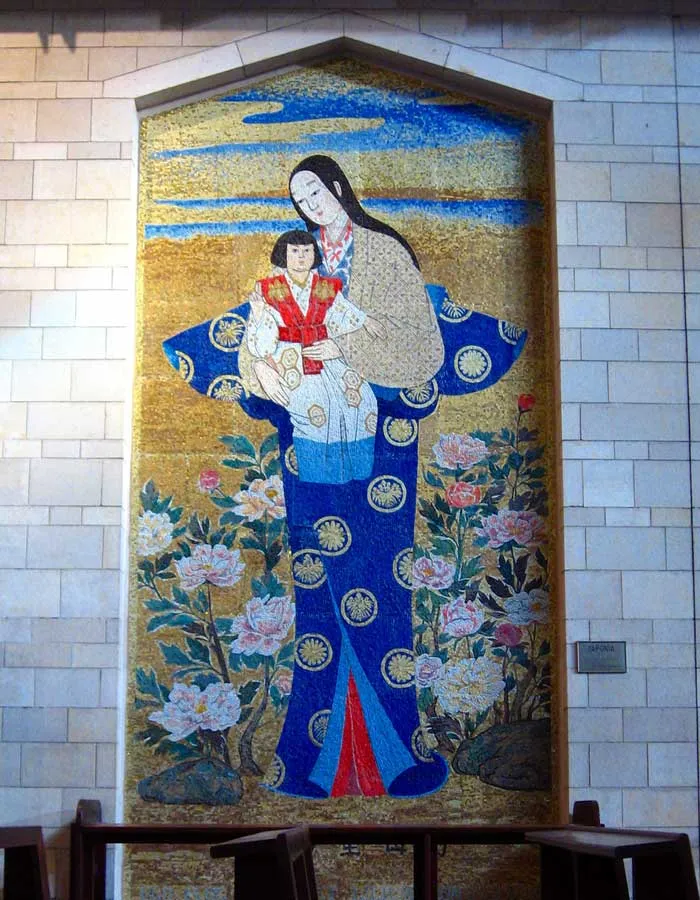
The Feast of the Annunciation
The Feast of the Annunciation was celebrated as early as the fourth or fifth century. The first certain mentions of the feast are in a canon, of the Council of Toledo in 656, where it was described as celebrated throughout the Church, and in another of the Council of Constantinople “in Trullo” in 692, which forbade the celebration of any festivals during Lent, excepting the Lord’s Day (Sunday) and the Feast of the Annunciation. A Synod of Worcester, England in 1240 forbade all servile work on the feast.
As this feast celebrates the Incarnation of the Second Person of the Trinity, many Church Fathers, including St. Athanasius, St. Gregory of Nyssa, and St. Augustine, have expounded on it. From the earliest recorded history, the feast has been celebrated on March 25, commemorating both the belief that the spring equinox was not only the day of God’s act of Creation but also the beginning of Christ’s redemption of that same Creation.
All Christian antiquity held 25 March as the actual day of Jesus’ death. The opinion that the Incarnation also took place on that date is found in the pseudo-Cyprianic work “De Pascha Computus”, c. 240. It says that the coming of Jesus and his death must have coincided with the creation and fall of Adam. And since the world was created in spring, Christ was also conceived and died shortly after the equinox of spring.
Similar calculations are found in the early and later Middle Ages, and to them, the dates of the feast of the Annunciation and of Christmas owe their origin. Consequently the ancient martyrologies assign to the 25th of March the creation of Adam and the crucifixion of Jesus; also, the fall of Lucifer, the passing of Israel through the Red Sea and the immolation of Isaac. The Medieval Golden Legend identifies 25 March as not only the date of Creation and Annunciation, but also a large number of other significant events in salvation history, including Good Friday of Christ’s crucifixion and death.
In the tradition of the Western Churches (Catholic Church, Anglican, Lutheran, and Western Rite Orthodoxy), the feast is moved if necessary to prevent it from falling during Holy Week or Easter Week or on a Sunday on the liturgical calendars. To avoid a Sunday before Holy Week, the next day (26 March) would be observed instead. In years such as 2016 when 25 March fell within Holy Week or Easter Week, the Annunciation is moved to the Monday after the Octave of Easter, i.e., the Monday after the Second Sunday of Easter.
In the tradition of the Eastern churches, (Eastern Orthodox, Oriental, and Eastern Catholic) the feast of the Annunciation is never moved under any circumstance. They have special combined liturgies for those years when the Annunciation coincides with another feast. In these churches, even on Good Friday a Divine Liturgy is celebrated when it coincides with the Annunciation.
One of the most frequent accusations brought against New Calendarism is the fact that in the New Calendar churches (which celebrate the Annunciation according to the New Calendar, but Easter according to the Old Calendar), these special Liturgies can never be celebrated any more, since the Annunciation is always long before Holy Week on the New Calendar. The Old Calendarists believe that this impoverishes the liturgical and spiritual life of the Church
Greek Independence Day is celebrated on the feast of the Annunciation and 25 March is also a national holiday in the Lebanon.
The date is close to the vernal equinox, as Christmas is to the winter solstice; because of this the Annunciation and Christmas were two of the four “quarter days” in medieval and early modern England, which marked the divisions of the fiscal year (the other two were Midsummer Day, or the Nativity of St. John the Baptist, on 24 June, and Michaelmas, the feast day of St. Michael, on 29 September).
When the calendar system of Anno Domini was first introduced by Dionysius Exiguus in AD 525, he assigned the beginning of the new year to 25 March, because according to Christian doctrine, the age of grace began with the Incarnation of Christ at the Annunciation, on which date Jesus Christ is believed to have been conceived in the Virgin Mary by the Holy Spirit.
Pope John Paul II established March 25 as the International Day of the Unborn Child, for its commemoration of the conception of Jesus.
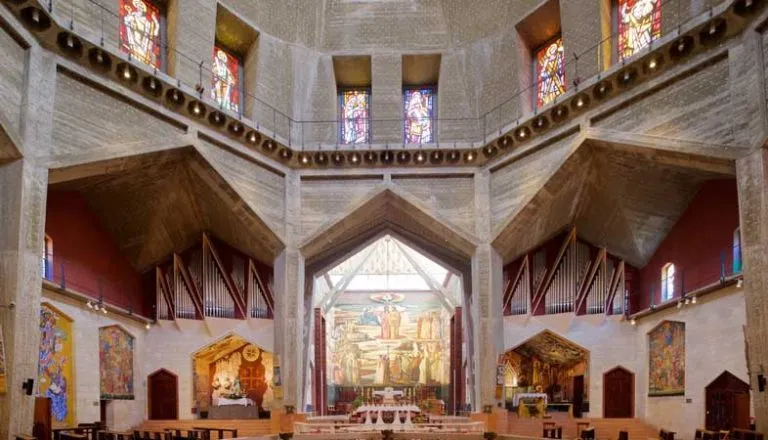
Mass Time
Weekdays
Saturdays
Sundays
Church Visiting Time
Contact Info
Al-Bishara Street 12,
Nazareth, Israel
Phone No.
Tel : +972 4-657-2501
Accommodations
How to reach the Basilica
Tel Aviv (TLV) Airport is the nearest airport to the Basilica.
Migdal HaEmek–Kfar Baruch railway station is the nearest train station to the Basilica.

